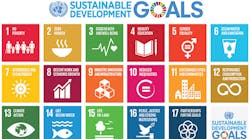Last year the United Nations set out 17 Sustainable Development Goals (SDGs) that area to be achieved by 2030.
Looking at the feasibility of meeting these goals DNV GL, earlier this month, released a report called “Spaceship Earth.” While the report shows that none of the goals will be met in all regions of the world, it did showcase global companies driving extraordinary progress on each of the global goals.
The report highlights 17 global companies at the frontier of progress on the SDGs; Tata, Danone, HiTechnologies, ARM, Symantec, Grundfos, SolarWorld, NYK, Hydro, Safaricom, Siemens, Marks & Spencer, Iberdrola, Cermaq, APP, Calvert Investments and Unilever. These companies are pioneers, the report says that are driving sustainable change through innovations, partnerships and adjustment of business models. The Sustainable Development Goals have become a blueprint for companies to reshape and future-fit their business.
“For the most part, business has the technology, people and processes to rock the world,” said Remi Eriksen CEO of DNV GL. “The challenge, therefore, isn’t the ‘smarts’, it’s the take-up of the solutions proposed and piloted – the real scaling of these interventions.”
The report notes that due to the scale of the challenge urgent, extraordinary action is now needed.
Key findings from the ‘Future of Spaceship Earth’ report:
None of the global goals will be met in all regions of the world
- Moreover, not even half of the goals will be met in any of the regions
- We need to step up our collective efforts to reach the goals
The world is making progress towards most of the global goals
- Good health and well-being (3), Quality Education (4), Clean Water and Sanitation (6), Affordable and Clean Energy (7) and Industry, Innovation and Infrastructure (9) have the most positive outlooks
- We are also moving in the right direction on several other goals, particularly for human development such as Poverty (1), Hunger (2) and Gender Equality (5)
The progress is not fair enough
- The Reduced Inequality (10) goal is likely to be the area of least progress, with red indicators forecast in all regions
- Within countries, the inequality gap will continue to widen – and between counties, developing nations will continue to lag behind
The energy transition is not fast enough
- The replacement of fossil fuels with renewable energy sources is underway
- On the current trajectory, we will exceed the carbon budget by the year 2037, entering increasingly dangerous climate change territory
The energy demand will level off
- From 2030 onwards, the growth in energy demand will level off, due to the fact that improvements in energy efficiency will outpace the energy demands created by growth in population and productivity
- Increases in urbanization and education will result in lower fertility rates, reducing energy demand
- Lower productivity growth in more mature service economies also will also lead to stabilization of energy demand
Lack of climate action is a showstopper
- Lack of sufficient progress on climate action forms a barrier towards achieving most other global goals
- It will be increasingly difficult to achieve most of the global goals in a world with increased climate change
Business is ready for extraordinary action
- Private sector has a key role to play, representing 60% of the world’s GDP. Business can be the swing factor: the actions companies choose to take have the power to amplify change – for better or for worst
- The business case for sustainable development is showcased in the report with examples from frontier companies taking extraordinary action for the global goals



